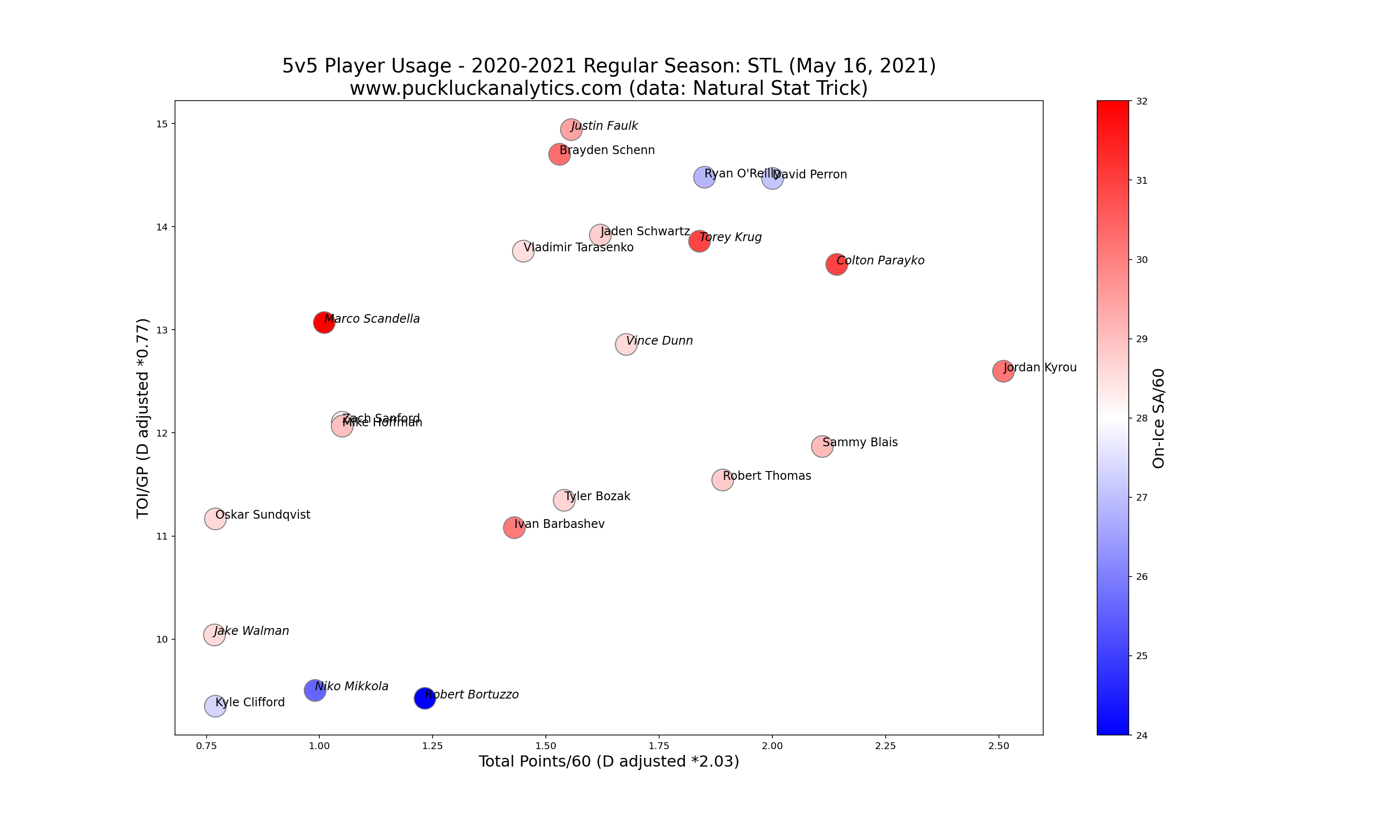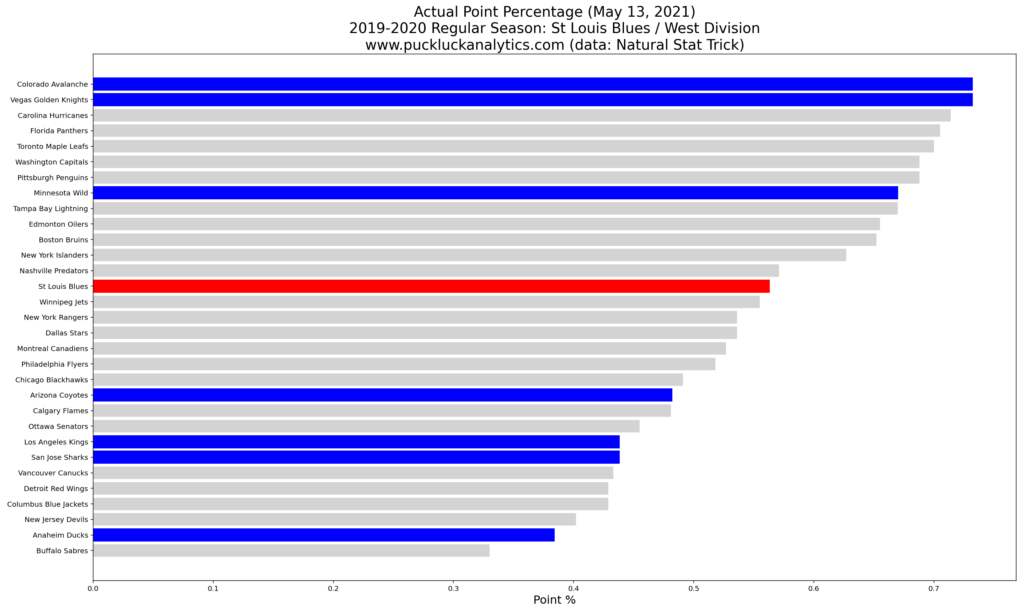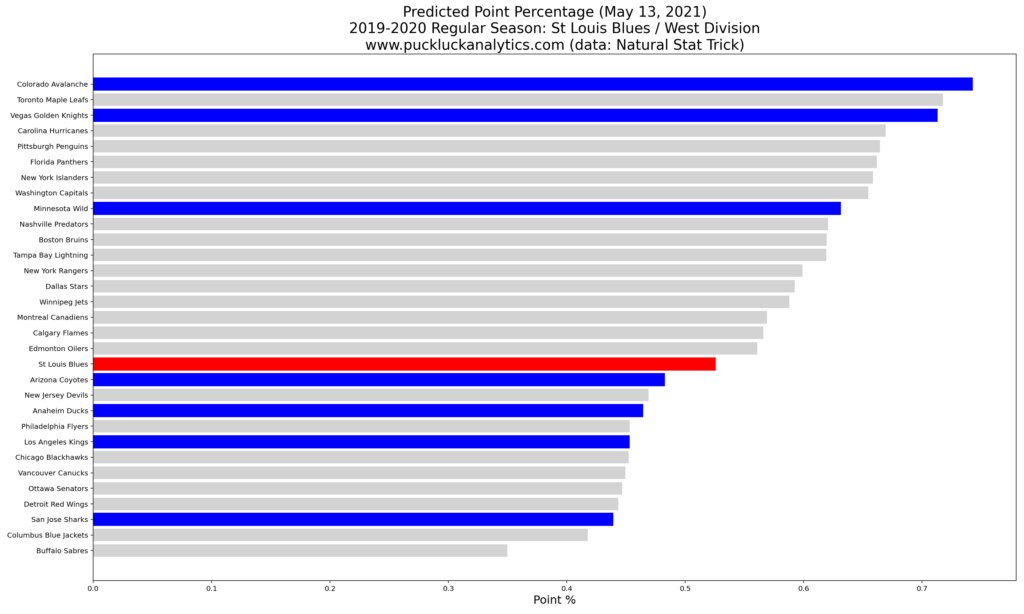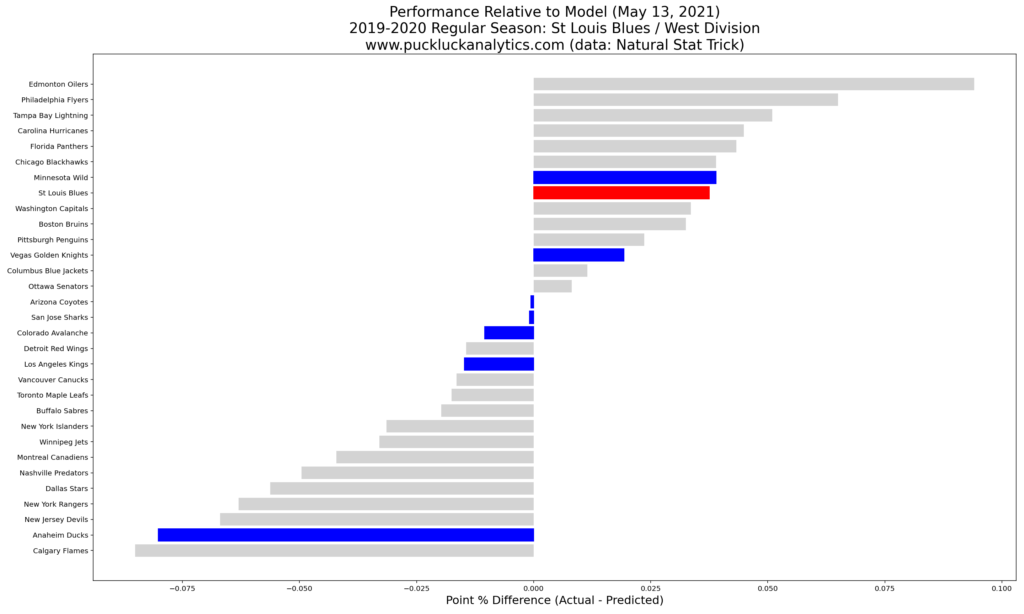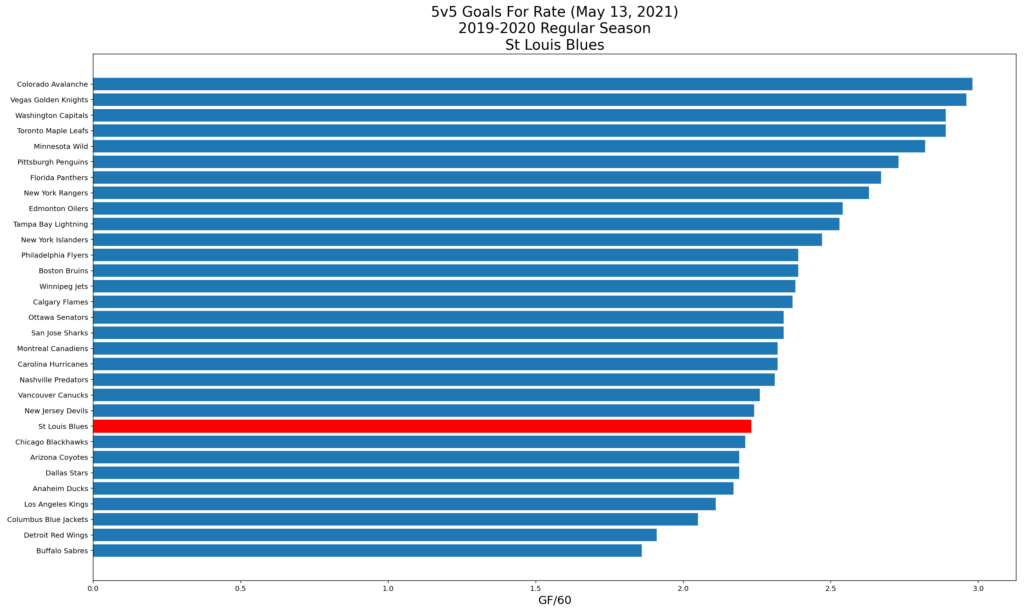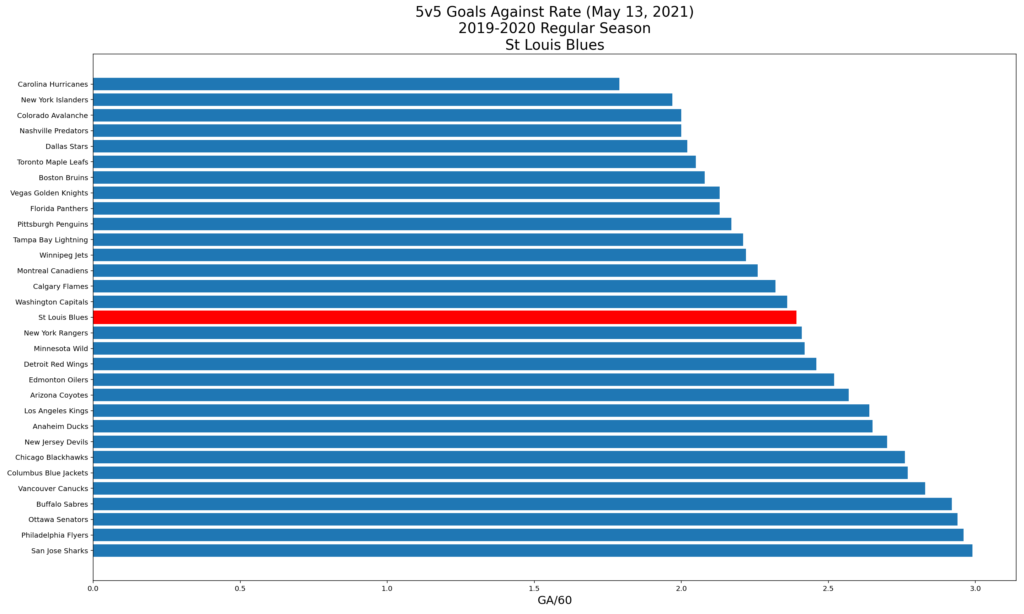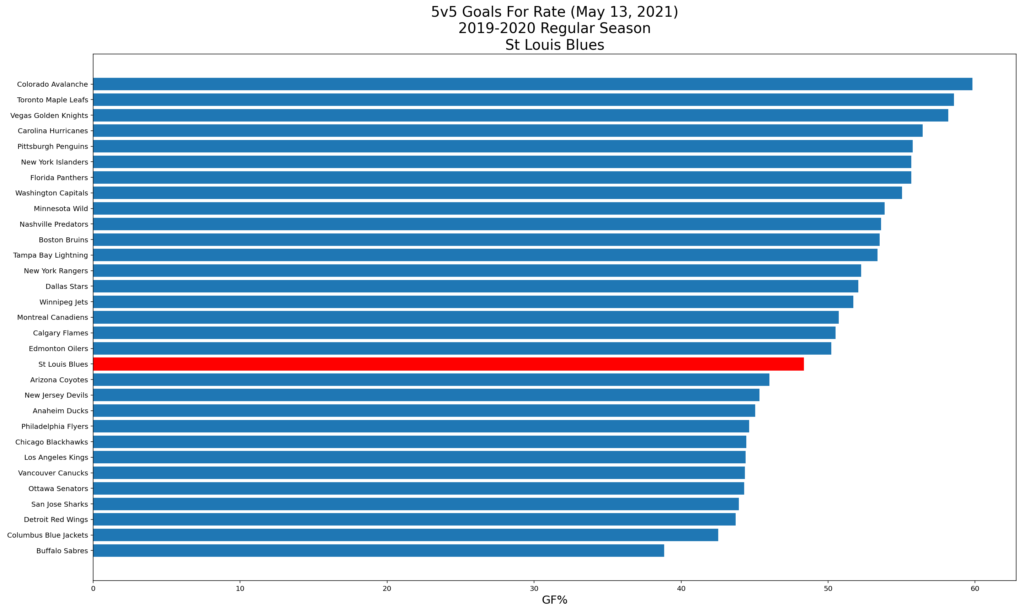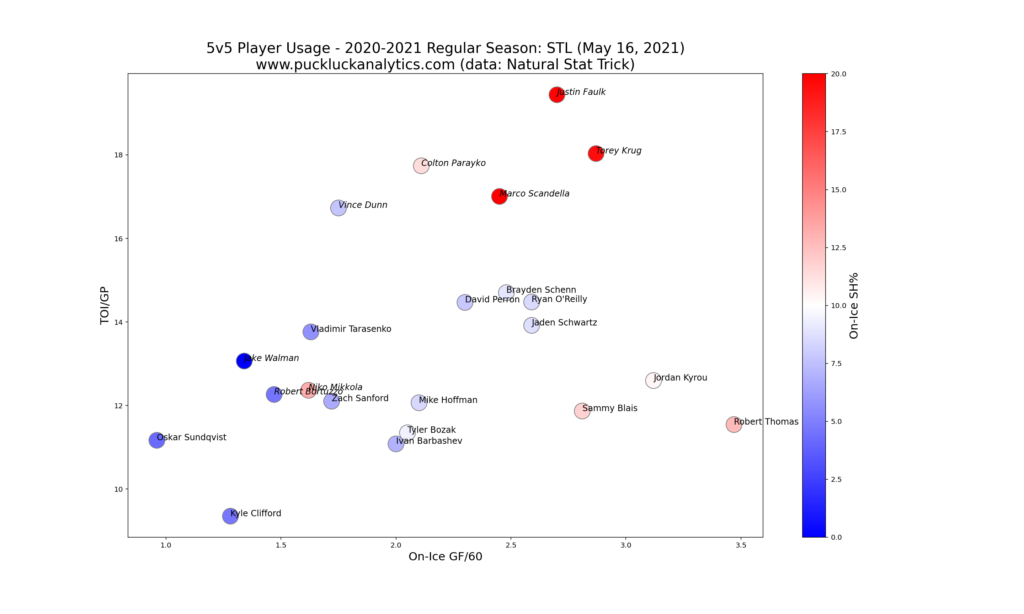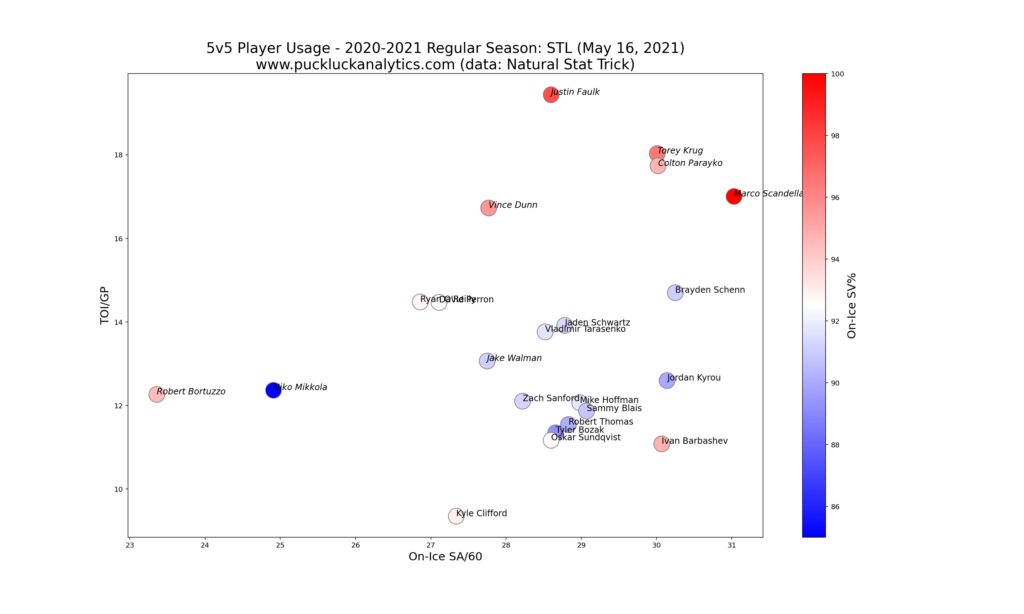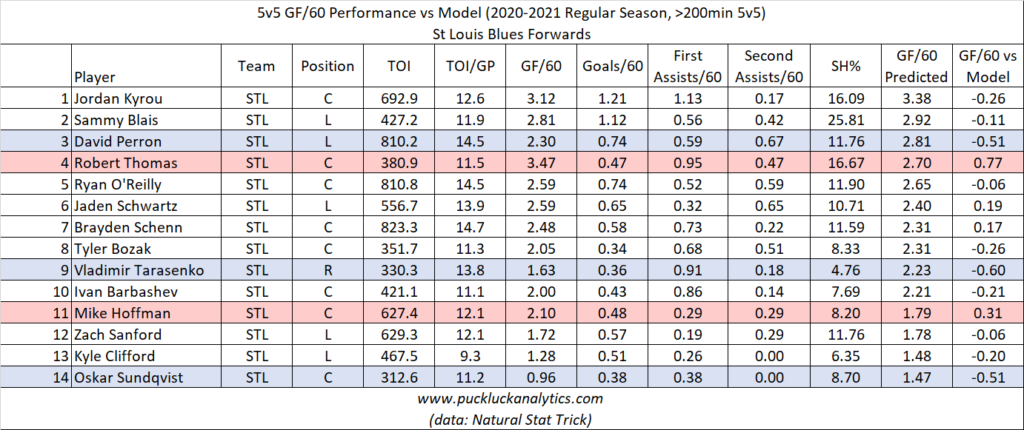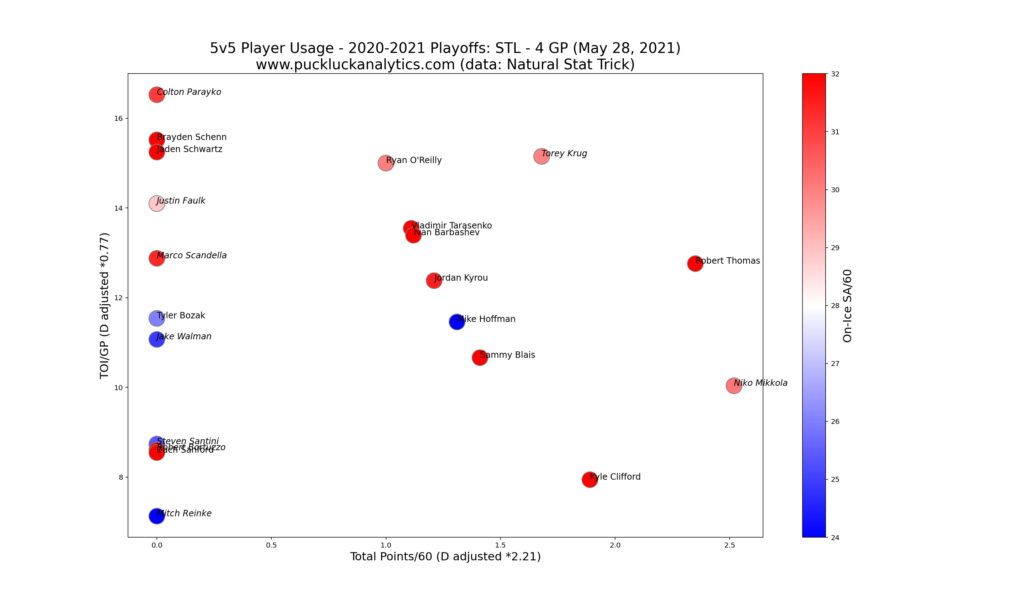After a middling regular season performance that saw them outlast the Arizona Coyotes for the final playoff spot in the West Division, the Blues were simply not good enough to compete with the Colorado Avalanche in the first round of the playoffs. We’ll see if we can understand how the Blues almost fell out of the playoff picture just two years removed from their Stanly Cup win as we a look at the 2020-2021 Blues season. For more detail on the plots we’ll look at in the review, check out this post.
Overall Performance (Regular Season)
The Blues fought their way into the final West Division playoff spot, outlasting the Coyotes down the stretch. Let’s take a look at their results in comparison to our points predictor model, which uses only 5v5 data as input.
The Blues outperformed the model by a significant margin. We see that the model predicts the Blues finishing closer to the non-playoff teams in the division than the top 3. This is concerning looking to next season since it suggests their success this season was somewhat predicated on more variable factors such as special teams and overtime results than it was on their 5v5 play.
Let’s look at the 5v5 goal rates that feed into the points predictor model.
The Blues defensive results at 5v5 were right in the middle of the league rankings. Offensively, they struggled to score goals this season and the result was a less than stellar GF% at 5v5. The Blues need to find some additional offense if they want to avoid slipping out of the playoff picture next season.
Player Performance (Regular Season)
We’ll start evaluating individual player performance by looking at a player usage chart for 5v5 situations. The stats for defensemen have been factored for comparison with forwards in this chart and we get a visual depth chart as a result. The top players should appear at the top right, with the rest of the roster distributed along the diagonal from there.
We do see a diagonal distribution, however it is very wide. It almost looks as though there are two separate diagonal lines, which suggests that player usage was not optimal this season. Along the top line, we see many of the Blues’ veterans, such as Ryan O-Reilly and David Perron, who were key cogs in the Blues’ Stanley Cup run two years ago. Along the lower line, we see younger players like Jordan Kyrou and Robert Thomas. With the gap between these two groups, it appears that the first group was over-utilized while the second was under-utilized.
We’ll look at relative offensive impacts by plotting on-ice GF/60 vs TOI/GP. Players who appear further to the top right of this chart had greater contributions to team GF/60.
Kyrou, Thomas and Sammy Blais stand out on this chart. With the highest offensive impacts, they had significantly less ice time than a number of the Blues veteran forwards. The Blues could increase the impact from these players by putting them in larger roles.
We’ll take a similar look at defensive impact using SA/60 vs TOI/GP. This time, players further left and down contributed better impacts to team GA/60.
Robert Bortuzzo and Niko Mikkola stand out on this chart with defensive impacts much better than most of the roster. Otherwise, the Blues are all grouped relatively closely on the low side of league average (30 SA/60). Based on defensive impacts, it’s hard to find a reason why the under-utilized group from above wasn’t given a larger opportunity.
Next, we’ll look at our on-ice GF/60 models. Looking at the variance between the model output and actual on-ice GF/60 gives us an indication of whether players carried their line mates offensively. We’re looking for variances over about 0.3 and negative variances signify that a player carried his team mates offensively.
Looking at the forwards, we see Kyrou had the highest on-ice GF/60 predicted by the model. While his high shooting percentage suggests the model is a bit on the high side, he looks like a solid offensive option for the Blues. Perron and Vladimir Tarasenko stand out as having carried their line mates offensively. In Tarasenko’s case, it may be more than we initially suspect due to his measly 4% shooting lowering his model prediction. On the other side, Thomas and Mike Hoffman outperformed the model significantly and look like they were carried by their line mates. It looks as though the Blues could gain some offensive impact simply by doing some line shuffling.
We see a large discrepancy in the model variances among defensemen, with none of the Blues d-men’s actual results near the model. Once again, it looks like some shuffling among the defense pairings could give the Blues a boost. Players like Vince Dunn and Bortuzzo look like they could take on larger roles, while Torey Krug and Justin Faulk should have reduced roles.
Jordan Binnington had a good season as the Blues starting netminder. Ville Husso filled in with backup duties, however wasn’t near Binnington’s level. The Blues could improve their overall defensive numbers with improved performance from their backup next season.
Playoff Performance
The Blues were swept in the first round by a powerhouse Avalanche team. While four games is hardly a large enough sample to make any long term predictions, the playoff usage chart below give us some indication as to what happed in the Blues short playoff run.
The Blues had offensive production from throughout their lineup in their four playoff games, however a few of the Blues’ top players didn’t hit the scoresheet at 5v5. It’s also clear that the Blues simply couldn’t hold off the Avalanche’s onslaught from the number of bright red markers indicating high on-ice SA/60. Binnington was decent in net but not good enough to steal a series, with a 0.917 save percentage at 5v5 over the four games.
Looking Ahead
The Blues have over $66M in cap space for 2021-2022 tied up as they head into the offseason.
Key RFAs:
The Blues have a handful of RFA forwards, with Kyrou and Thomas being the most notable. Both are coming off their entry level deals and will likely get significant raises. With Kyrou looking like the most impactful forward in our review, he should their top priority. Thomas also had a strong impact this season, although we saw signs that he was carried by line mates to some extent so the Blues should be careful not to overcommit.
The Blues also have Vince Dunn to sign as an RFA on defense. We saw signs that he could take on a larger role and the Blues should ensure they can lock him up.
Key UFAs:
The key UFAs for the Blues this offseason are all in their forward ranks. Jaden Schwartz, Tyler Bozak and Mike Hoffman are all headed for the open marked. With their RFAs likely to eat up a significant chunk of their available cap space, it’s unlikely that all three will be back with the Blues next season.
Key Players Under Contract:
O’Reilly, Tarasenko and Brayden Schenn combine for $21.5M against the cap next season. With our review suggesting they were over-utilized this season, they either need to produce more or be shifted to slightly lesser roles next season. If the Blues can integrate them with their younger impact players more effectively, these veterans can still have a big impact on the Blues’ success next season.
Tough Questions:
While head coach Craig Berube earned much credit for the turnaround two season ago that took the Blues to the Stanley Cup, we saw evidence in our review that players weren’t utilized effectively this season. It appears that the key players from the Blues cup run are still being relied on heavily despite the continuing evolution of the team and it’s younger players. Will Berube make the necessary adjustments heading into next season or is it time for another coaching change in St Louis?
Offseason Priority:
Locking up their key RFAs and filling the holes left by departing UFAs should be the Blues priority this offseason. If they can find some value contracts to fill their roster holes left by departing UFAs and if they utilize their players more effectively next season, they should be a playoff caliber team again.
Check out my other season reviews, such as the Dallas Stars and the New York Rangers, and subscribe to catch the rest of my season reviews as they come out.
data: Natural Stat Trick
cap data: CapFriendly
